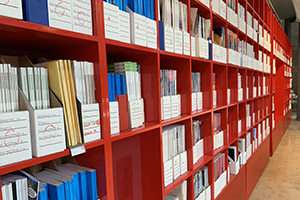Using copyrighted material in publications
If you want to republish someone else's copyright protected material in degree project reports, doctoral theses or scientific articles you need to find out if it is allowed. Sometimes the material is available under a license that allows reuse. If not, you need to ask for permission
When you publish something yourself, you also need to think about your own copyright.
Creative Commons licenses (CC licenses)

The author or rights holder may allow use of a work with a license. The most common are CC licenses. All CC licenses allow you to use and distribute the work. There are different variants of these licenses, which for example specify whether you may make adaptations of the material or whether in commercial use is allowed. You must always state the creator. Most open access articles and open access books have a CC license.
Permission
If there is no license or agreement for the material, you must contact the author or the publisher to ask for permission. Who holds the copyright can be indicated in or in connection with the source, for example in a caption, somewhere on the website or on the first pages of a book or newspaper. Specify how and where you want to use the material. Save the permission you receive as using copyrighted material without permission may have legal consequences. If you are unable to get hold of the authors or are unsure of what applies, it is better not to use the material. For most scientific articles, you can request permission by filling out a form. Permission to use a figure or table in a degree project, a thesis or a scientific article is usually granted free of charge. The Copyright Clearance Center handles copyright for many scientific journals and books.
Your rights to reuse yor own text or figure from an article in your doctoral thesis or other publication depend on your agreement with the publisher. You may need to ask for permission in these cases as well.
Different types of works
Text
You may not publish other people's copyrighted texts. However, you may reproduce the content of other people's texts in your own words. Provide references to the sources you use. You may also quote "in accordance with good practice" and to the extent justified by the context. This means that you reproduce the exact wording of the source, mark that it is a quotation, and indicate the source with a reference. If you are a student or researcher, the management of sources is also part of the academic practice. You need to manage sources to avoid plagiarism.
Images
Copyright also applies to photos, maps, sketches, drawings, and other images that are published in printed or electronic form. There are collections of images with different license terms that may be used without first asking permission from the creator. Tips on where to find image collections that you can use without permission can be found at Karlstad University Library. Adapted images are also protected by copyright. This applies if you for example crop the image or add a detail. If, on the other hand, you make your own image, you own the copyright. Of course, it can sometimes be difficult to draw the line between an adapted image and an original image.
AI-generated images
AI-generated images are not subject to copyright, as only natural persons can hold copyright. However, there may be restrictions on how the images may be used in the usage terms for the AI tool. You can’t claim that you are the creator of an AI-generated image. You should also check if there are recommendations on how to state that you used a particular tool to create the image.
Tables and graphs
For tables, diagrams, charts and other graphs it is the design and not the content that is protected by copyright. You can therefore use the presented data and make your own tables and graphs. You must refer to the source from where you obtained the information. If you want to use the table or graph directly from the source, it is usually necessary with a license that allows it or that you ask for permission.
Computer code and software
Computer code and software are protected by copyright. To publish computer code, for example in a degree project or a thesis requires that there is a license or agreement, or that you ask for permission. Software can sometimes also be protected by patents.
Research data
Research data can also be protected by copyright (see heading Copyright, patents and other intellectual property rights).
